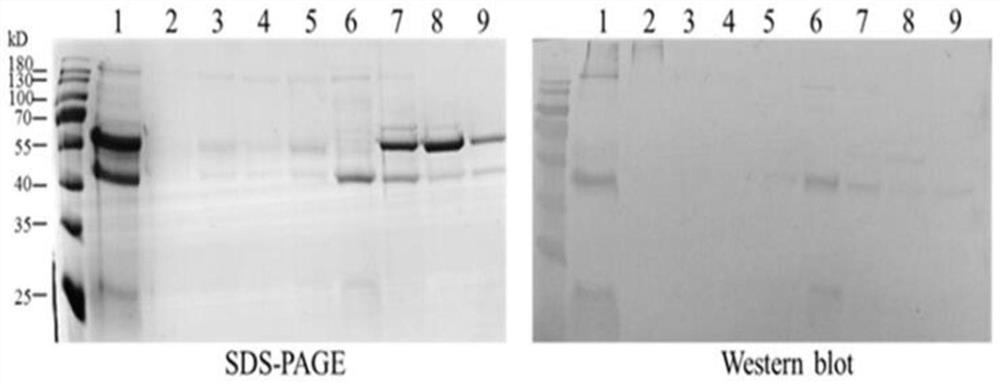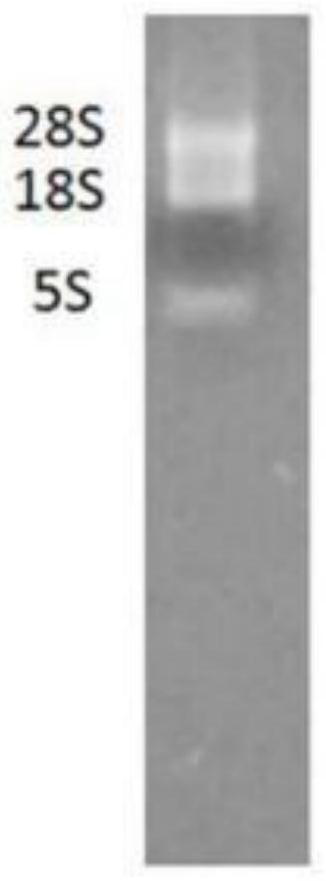A kind of anti-ca125 nanobody 5d2 and its application
A technology of CA125 and nano-antibodies, which is applied in the field of immunology, can solve the problems of specific antigen-antibody binding reactions and affect detection efficiency, and achieve excellent detection performance
- Summary
- Abstract
- Description
- Claims
- Application Information
AI Technical Summary
Problems solved by technology
Method used
Image
Examples
Embodiment 1
[0029] Example 1. Preparation of natural CA125 antigen
[0030] 1.1 Purification of CA125 in ascites of ovarian cancer patients by saturated ammonium sulfate precipitation
[0031] Stir 2L of ascites from a patient with ovarian cancer in an ice bath on a magnetic stirrer, slowly add 228g of ammonium sulfate to make the final concentration of ammonium sulfate 20%, let it stand overnight at 4°C, centrifuge at 10,000g for 10 minutes, and save the supernatant. Stir the supernatant in an ice bath on a magnetic stirrer, slowly add 524 g of ammonium sulfate to make the final concentration of ammonium sulfate 60%, let it stand overnight at 4° C., centrifuge at 10,000 g for 10 minutes, and retain the precipitate. Use about 400ml of PBS solution to blow and mix the precipitate, centrifuge at 10000g for 10 minutes, and save the supernatant. Concentrate the supernatant to 200ml with 4000g of 100kD ultrafiltration tube, and divide into 50ml / tube.
[0032] 1.2 Purification of CA125 in asc...
Embodiment 2
[0036] Example 2. Construction and screening of Nanobody phage display library
[0037] 2.1 Immunity of alpacas
[0038] A healthy adult alpaca was selected, and the CA125 antigen (GenBank: AAO52683.1, constructed on the pCDNA3.1 vector through HindⅢ and EcoRI restriction sites, expressed by human 293 cells using conventional molecular biology techniques) and Freund's adjuvant was mixed at a ratio of 1:1, and the alpaca was immunized with 6-7 μg / kg subcutaneously at multiple points on the back for a total of four immunizations with an interval of 2 weeks. Afterwards, the peripheral blood of the alpaca was collected for the construction of a phage display library.
[0039] 2.2 Isolation of camel-derived lymphocytes
[0040] Lymphocytes were separated from the collected alpaca peripheral blood using the Camel Peripheral Blood Lymphocyte Separation Solution Kit (Tianjin Haoyang Company, Cat. No. LTS1076). 7 Add 1ml RNA isolation reagent to each living cell, take 1ml for RNA ex...
Embodiment 3
[0069] Example 3. Preparation of Nanobody 5D2
[0070] 3.1 Amplification of original nanobody strain TG1 and transformation of nanobody recombinant plasmid into Escherichia coli BL21(DE3)
[0071] Inoculate the original strain TG1 Glycerolbacterium containing Nanobody nucleic acid in 5ml of fresh LB-A medium at a ratio of 1:1000, and culture overnight at 37°C and 200rpm. The next day, plasmids were extracted using the Plasmid mini kit (OMEGA) according to the instructions. After verification, transform 1 μl of the above plasmid into 100 μl competent cells, mix gently, place on ice for 30 minutes, heat shock in a water bath at 42°C for 90 seconds, and cool in an ice bath for 3 minutes. Add 600 μl LB medium to the centrifuge tube, shake and incubate at 37°C for 60 minutes. Take 100 μl of the supernatant, spread it on the LB-A plate with a triangular spreader, and culture it upside down at 37°C overnight.
[0072] 3.2 Induced expression of nanobodies
[0073] The above monocl...
PUM
| Property | Measurement | Unit |
|---|---|---|
| molecular weight | aaaaa | aaaaa |
Abstract
Description
Claims
Application Information
 Login to View More
Login to View More - R&D
- Intellectual Property
- Life Sciences
- Materials
- Tech Scout
- Unparalleled Data Quality
- Higher Quality Content
- 60% Fewer Hallucinations
Browse by: Latest US Patents, China's latest patents, Technical Efficacy Thesaurus, Application Domain, Technology Topic, Popular Technical Reports.
© 2025 PatSnap. All rights reserved.Legal|Privacy policy|Modern Slavery Act Transparency Statement|Sitemap|About US| Contact US: help@patsnap.com



